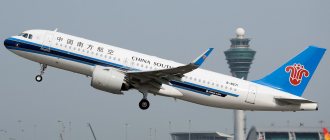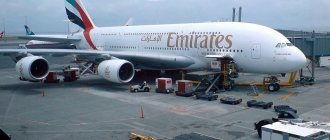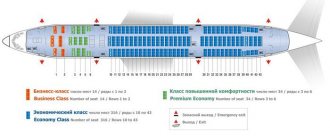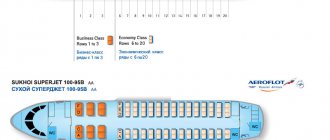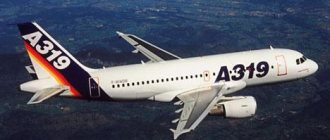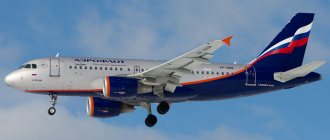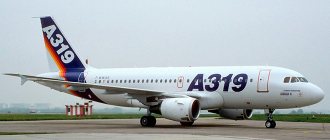One of the first attempts by European countries to build a passenger aircraft for intercontinental (transatlantic) flights was the construction of the experimental Bristol Brabazon airliner. The attempt was unsuccessful.
In the early 60s, the long-range 4-engine Vickers VC-10 was launched into production in Great Britain, but it did not gain much popularity. But the American Boeing 747, despite fears, has gained massive popularity in the international market. The American monopoly was put to an end only in the 80s, when the development of the 4-engine European airliner A340 began.
A340 concept
The main message of the development company: overcoming intercontinental routes. This load requires exceptional cost efficiency. The Airbus A340 was equipped with four engines capable of covering long distances. It was assumed that modern equipment would make the design slightly lighter, thereby reducing the volume of fuel.
Technical characteristics of the Airbus A340-300 aircraft
- First flight: October 25, 1991
- Years of serial production: from 1992 to 2008
- Length: 63.69 m.
- Height: 16.91 m.
- Empty weight: 130900 kg.
- Wing area: 361.6 sq.m.
- Wingspan: 60.30 m.
- Cruising speed: 870 km/h.
- Maximum speed: 920 km/h.
- Ceiling: 12400 m.
- Flight range: 12700 km.
- Take-off length: 2995 m.
- Run length: 1925 m.
- Engines: 4 turbofans CFM56-5C4
- Crew: 2 people
- Number of passenger seats: 295 seats in three classes or 440 in one class.
Airbus A340-300. Gallery.
Airbus A340-300 video
Hi-tech
The airliner is a turbojet wide-body passenger aircraft. This aircraft has a common base with its twin-engine “brothers”.
Improved wing design, it is created from high-strength aluminum alloys and composite alloys. The aerodynamic profile of the wings is unique; their load-bearing properties lighten the weight of the aircraft and reduce the volume of fuel.
Composite materials are widely used in the construction of the fuselage. The chassis is three-post. There are dual wheels in front. The car has an automatic braking system.
The demands placed on the engines were unprecedented. Two pairs of CFM 56-5С2 engines with a thrust of 4 × 146.3 km. Constantly improved and refined, increasing economic feasibility and facilitating maintenance, as well as its cost. A digitized electronic motor tuning system provides the necessary accuracy in maintaining motor parameters in the optimal position. On a long flight, increased fan efficiency is also important. What has been improved by motor manufacturers.
Satellite system for in-flight orientation, automatic navigation system. Special instruments were installed to monitor the four engines, which required an increase in the cockpit.
The comfortable pilot seats can move in three directions using an electronic system. The backrest reclines, the pedals and armrests are adjustable.
The steering wheel is missing - it was replaced with side handles.
For its time, the airliner had excellent technical data: an entirely remote, electronic control system; joysticks instead of steering wheels; instruments with arrows have been replaced by liquid crystal displays; as well as a large number of composite materials in the structure.
Design
A340 is a 4-engine wide-body low-wing aircraft with a high aspect ratio wing. When designing, the designers tried to ensure unification with Airbus aircraft in production. Thus, fuselage sections from the A300 and A310 were used, and the fly-by-wire control system with side joysticks instead of steering wheels was from the A320. The instrument panel was initially equipped with 6 cathode-ray monitors, which were later replaced with liquid crystal ones.
The A340 wing has powerful mechanization, including 7-section automatic slats and spoilers, which also function as flaps. The wing itself is distinguished not only by its high aspect ratio, but also by its greater relative thickness and is equipped with vertical tips. Early modifications of the aircraft were equipped with CFM56 turbofan engines; later series were equipped with Rolls-Royce Trent engines.
Tests
The production of two modifications began: A340 - 200 and A340 - 300. They accommodated 262 and 295 passengers, respectively. Test flights began in 1991-1992. Lengthy procedures continued to certify components and the design of the aircraft as a whole.
1993 - The A340-300 was chartered by French airlines, and the German airline Lufthansa received the A340-200. In the same year, an aircraft from Germany made a round-the-world flight from Paris to New Zealand. At the same time, he made only one landing, having additional fuel tanks. This world record was not broken for four years.
Such an impressive colossus required large amounts of fuel, for which Airbus could only partially satisfy customers. A more economical Boeing 777 aircraft appeared. Production volumes were reduced due to a sharp decrease in sales volumes of the aircraft.
During the 2000s, Airbus industry tried to improve and minimize the costs of subsequent maintenance of the aircraft, but failed. Production of the long-range A340 aircraft was completely discontinued in 2011. Over the previous two years, not a single copy was purchased by carriers.
History of creation
The European consortium Airbus entered the market with the twin-engine wide-body airliner A300. Practice has shown that even passengers prefer narrow-body aircraft for short-haul flights, and the “60-minute rule” reduced the possibility of operation on long-haul flights. Although soon safety standards were relaxed, and 2-engine aircraft were allowed to move away from airfields at a distance of 90 minutes of flight. However, it became obvious that the product line needed to be expanded by introducing a short-haul aircraft and a 4-engine long-range airliner.
Design of the new aircraft began in 1982. Initially it was going to be called "A330", but in 1986 it was decided that assigning a designation to a 4-engine airliner without a four in the index was "illogical". The name "A330" was transferred to the project of a new 2-engine aircraft, and the former "A330" became the A340. Construction of prototypes began in 1987, and carriers have already pre-ordered 89 Airbuses. The first flight took place in the fall of 1991, and the A340 entered service at the beginning of 1993.
A340: characteristics of the main models
- A340-300 entered service in 1993. It is the pioneer of the A340 family of aircraft. 295 passengers could fly in three classes: first, business and economy. The engines installed on it are exactly the same as on the A340-200: CFM56-5C, there are two pairs of them. In 1995, a variation of the A340-313X was released. An airliner with a higher take-off weight was purchased by Singapore. The flight range of the aircraft was increased by modifying the A340-313E, powerful engines were installed, and the aircraft was able to cover a distance of 13,500 km.
- The A340-200 aircraft is unique in that the length of the fuselage is less than the wingspan. Also shortened in length, it is capable of carrying 261 passengers. It flies excellently over oceans, covering distances of many thousands. The A340-200 was transformed, introducing various improvements (A340-8000 and A340-213X), setting a distance of 15,000 km. A total of 28 airliners were produced.
- Until 2006, the A340-500 was the farthest flying aircraft. In the sky since 2002. Passenger capacity - 313 people. The A340 -500 HGW flew over a distance of more than 16,000 km. The fuselage of the airliner was significantly lengthened, the area of the fin was reduced, and the wing was made with a larger area. The developers added fuel reserves, increased speed and installed Rolls-Royce Trent 553 engines.
- A340-600 began commercial flights in 2002. Its maximum distance, in different versions, is from 14,000 to almost 15,000 kilometers. It has up to 419 seats, depending on the configuration of the aircraft. In 2005, the A340-600HGW achieved a take-off weight of up to 380 tons, thanks to powerful engines and large fuel tanks. This is the world's second longest aircraft fuselage, 75.36 meters.
Technical characteristics of the Airbus A340-300 aircraft
- First flight: October 25, 1991
- Years of serial production: from 1992 to 2008
- Length: 63.69 m.
- Height: 16.91 m.
- Empty weight: 130900 kg.
- Wing area: 361.6 sq.m.
- Wingspan: 60.30 m.
- Cruising speed: 870 km/h.
- Maximum speed: 920 km/h.
- Ceiling: 12400 m.
- Flight range: 12700 km.
- Take-off length: 2995 m.
- Run length: 1925 m.
- Engines: 4 turbofans CFM56-5C4
- Crew: 2 people
- Number of passenger seats: 295 seats in three classes or 440 in one class.
Airbus A340-300. Gallery.
Airbus A340-300 video
Layout of seats in the cabin
First class passengers can convert their seats to beds, and on some models first class is equipped as a cabin. A menu, Internet access, the ability to charge your phone and multimedia are a bonus of this class.
Then there are business class seats. Legroom is good, the chairs also convert into beds, and socks and a blindfold are included. These are travel-friendly seats, with the exception of the last row. Directly behind them is the bathroom. The business class, as usual, is separated from the economic premises by a curtain or partition.
All economy class seats are also equipped with portable screens and comfortable armrests.
Traditionally, it is not advisable to reserve seats near the bathroom; this is the last row. There is a constant movement of people there, and queues can form.
When planning a flight, you need to familiarize yourself with the cabin layout. You should not choose places located in front of emergency exits. The backs of the seats in such places may not recline completely.
Overall, this is a comfortable, cozy aircraft with soft and comfortable seats.
Flight performance
Let's compare one of the later modifications of the A340 with the twin-engine Boeing 777, launched into production a little later. The 777, by the way, still remains the world's largest twin-engine airliner.
| A340-600 | Boeing 777-300ER | |
| Wingspan, m | 63,45 | 64,8 |
| Length, m | 75,36 | 75,36 |
| Maximum take-off weight, t | 380 | 351 |
| Range, km | 13980 | 13649 |
| Passenger capacity, persons | Up to 380 | Up to 390 (in three classes) |
The Boeing 777, being similar to the A340 in size and capacity (but with a single-class cabin layout could carry more than 500 people), “dry” outperformed it in terms of efficiency.
When the new Boeing was being designed, restrictions on the operation of 2-engine aircraft had already been lifted, and there was no longer a need to use 4 engines on a long-range airliner. After rising fuel prices, this advantage turned out to be decisive.
The Airbus A340 was a successful modern aircraft, as evidenced by the fact that its active operation continues to this day.
Probably, if not for the price jump, the “three hundred and fortieth” would still be produced to this day, competing with the “777”. The successor to the 4-engine Airbus was the A350 - with 2 Rolls-Royce Trent engines.
Technical specifications
Several tables combine the main technical parameters of all basic modifications of the Airbus A340 aircraft/
Comparison of 4 main modifications by size
| Dimensions | a340-200 | a340-300 | a340-500 | a340-600 |
| Length (m) | 59.4 | 63,7 | 67.93 | 75,36 |
| Wingspan (m) | 60.3 | 60.3 | 63,45 | 63,45 |
| Height (m) | 16,8 | 16,91 | 17,28 | 17,22 |
Comparison of 4 main modifications by flight parameters
| Dimensions | a340-200 | a340-300 | a340-500 | a340-600 |
| Cruising speed (km/h) | 871 | 881 | ||
| Maximum speed (km/h) | 913 | |||
| Flight range (thousand km) | 15 | 13,7 | 16,67 | 14,6 |
| Ceiling - max. flight altitude (thousand km) | 12,5 | |||
| Take-off runway length (m) | 3 000 | |||
| Landing strip length (m) | 1 926 |
A340 versions and modifications
The liner was produced in 4 different modifications.
They differed in carrying capacity and passenger capacity. Non-standard models were produced for special orders. A340-200. Despite its index, this version became the second development of the line. It takes 265 people on board. It has become an intermediate solution - it is undemanding in terms of resources, but it is far from capable of flying.
One of the first customers of this aircraft was the Sultan of Brunei. True, he never had time to fly - he died.
This is the only version with a wingspan greater than the length of the fuselage.
A340-300. Initially, this model was supposed to be the only development.
There were 295 people on board. This version has become an airline for many. Lufthansa has 30 aircraft in its fleet that fly long distances.
How does the number of seats depend on the interior layout?
| Layout | Number of places |
| Economy only | 440 |
| Economy + business | 335 |
| Three classes - Economy + business + first | 295 |
The A340-500 has become a real “long-hauler”. It took off on its first flight in 2002 with 313 passengers on board, the maximum number available to the ship. In 2006, the appearance of the Boeing 777-200 supplanted the airbus 340 as a long-hauler, however, the aircraft is capable of long-term non-stop flights from Heathrow (London, UK) to Perth (Australia).
A340-600. This model was a response to the appearance of the American Boeing 747. It carries 380 passengers. It is one of the longest aircraft in the world (second only to the 747-8).

